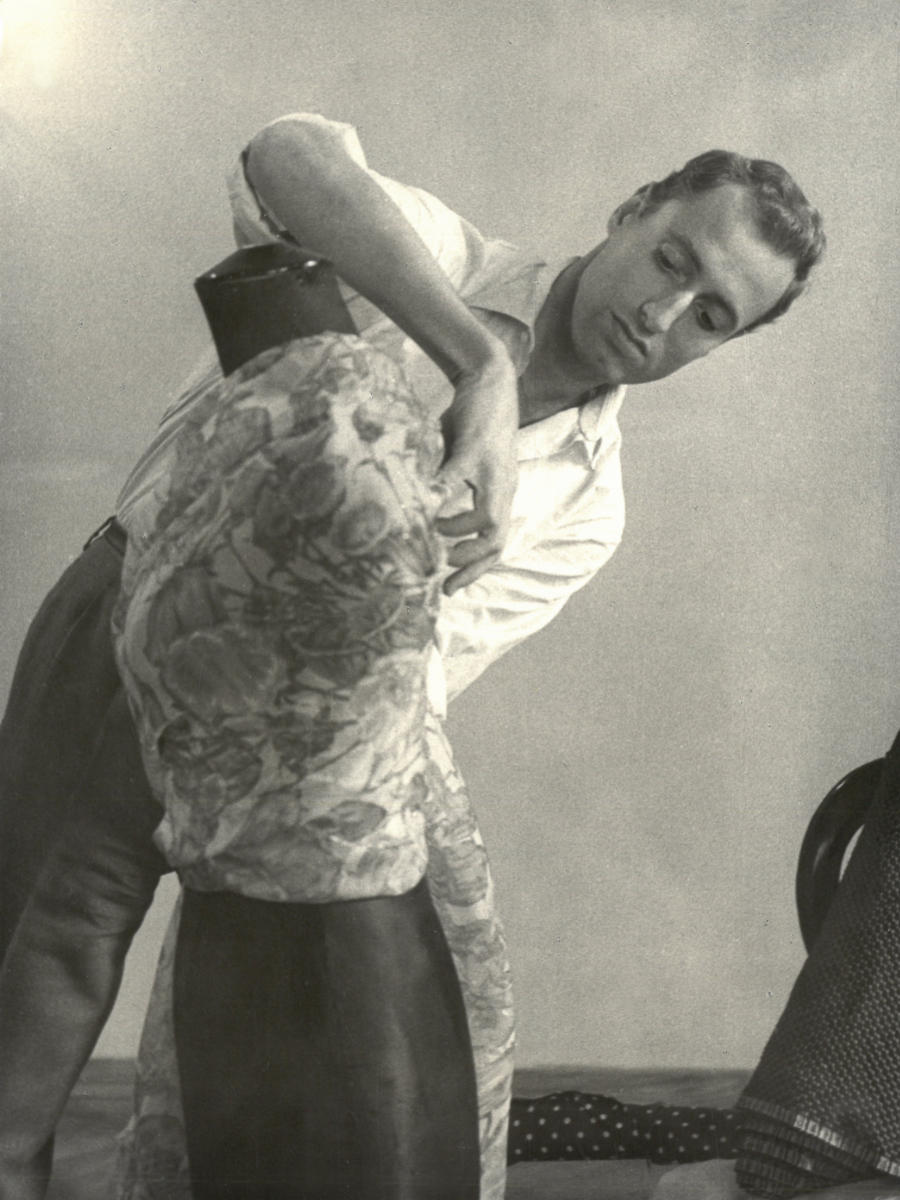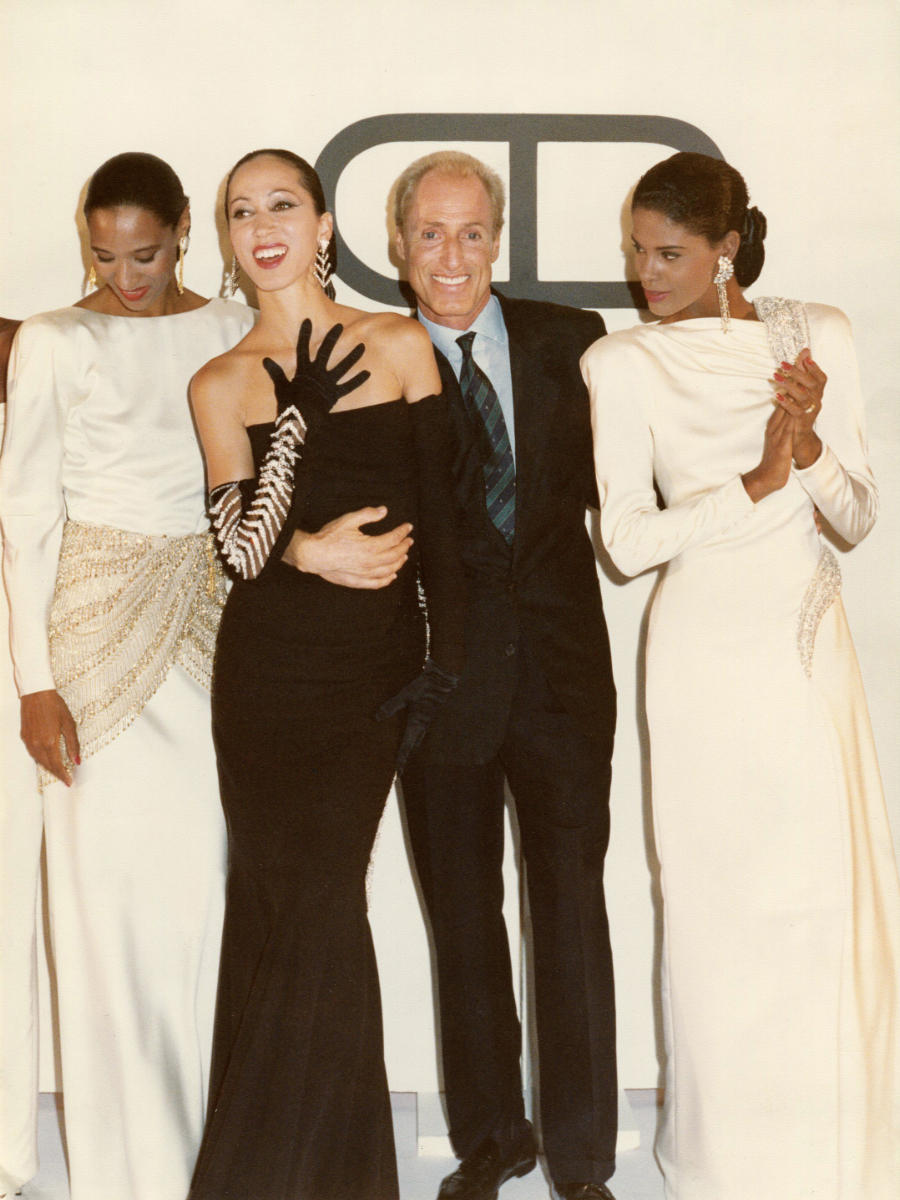Renato Balestra, the painter of fashion
Born in Trieste in 1924, Renato Balestra grew up immersed in the Mid-European cultural environment. In a family of architects and engineers, he stood out for his artistic spirit and explored painting, music and scenography in his free time.
His career in fashion began almost by chance, when friends send one of his sketches to the Italian Fashion Center (Centro Italiano della Moda, CMI): immediately noticed for his talent, he was invited to take part in a Haute Couture show. By 1953, he had achieved such success that he quit his studies in engineering and completed his apprenticeship at Jole Veneziani’s atelier.
Considered the “painter of fashion”, he leveraged his artistic spirit to create a unique synergy with Italian Haute Couture, which he deeply transformed over the decades. By the 1970s, he was famous for his signature “Embroidery Painting”, based on the original use of materials and actual painting on fabrics of any kind. His mastery of transparencies, through innovation and freedom of expression, spoke to modern, strong and sensual women.


In 1954, he moved to Rome and began working as a designer for prestigious fashion houses such as Emilio Schubert, Maria Antonelli and Sorelle Fontana. His strong passion for cinema led him to design costumes for Ava Gardner in The Barefoot Contessa and The Sun also Rises, for Gina Lollobrigida in Beautiful but Dangerous, for Sophia Loren in Lucky to Be a Woman, for Candice Bergen in The Adventurers, and for Shirley Jones, Micheline Presle and Giorgia Moll for Dark Purpose.
As the international jet set noticed his talent more and more, in 1958 he began presenting his collections across the United States, from Los Angeles to New York. He debuted in Hollywood with actresses such as Zsa Zsa Gabor, Tina Louise, Joan Bennett, Natalie Wood, Ann Miller, Arlene Dahl and Linda Christian. Appreciated and loved not only for his unique designs but also for his optimism, he became a favorite of movie stars like Liz Taylor, Claudia Cardinale, Marina Cicogna, Lydia Alfonsi, Daniela Rocca, Yvonne Furneaux, Carroll Baker, Candice Bergen, and Cyd Charisse.
In 1959, he opened his first Atelier in Rome at via Gregoriana 36. In 1961, he presented his first Spring-Summer Haute Couture Collection at the Galleria Nazionale d’Arte Moderna. Those were the years when “Balestra Blue” first appeared, on a short satin dress: a bright, magical and timeless hue, a unique color that remains an indisputable symbol of the Maison to this day.
In 1962, Renato Balestra became a member of Camera della Moda Italiana, and the Italian Institute for Foreign Trade (ICE) chose him to promote Made-in-Italy quality around the world.
In January 1963, Renato Balestra held his first show in Palazzo Pitti’s Sala Bianca, launching a completely new concept of fashion that stood out for its simplicity, accuracy and spontaneity. He developed this new approach designing exclusive collections for Isetan in Tokyo as well as leading American department stores Saks Fifth Avenue, Bergdorf Goodman, Foley’s, Neiman Marcus and Lord & Taylor.
By the end of the 1960s, the Renato Balestra brand was distributed in over 70 American department stores and showcased on runways in the Philippines, Singapore, Thailand, Japan, Malaysia, Indonesia, the Middle East and Far East. Soon, clients included the most powerful and elegant women in the world, from first ladies to princesses and empresses. Custom-made gowns and wedding dresses, highlighting various local cultures and materials, created a strong foundation for the designer’s long-lasting career.
In 1970, Renato Balestra had the innovative intuition to include menswear in a women’s fashion show – to great success. He was one of the first designers to create unisex collections and show them on co-ed catwalks, a true forerunner of the times.
In 1973, the registration of the Renato Balestra brand was completed. As one of the first designers to believe in licensing, Renato Balestra launched his namesake perfume in 1978 and went on to successfully explore and develop various products: not only fragrances, but also makeup, luggage, eyewear and homeware. His creativity enhanced further collaborations and flourished in skillfully executed uniforms for Philip- pines Airlines (1985), Alitalia Airlines (1986) and for the managers of the Agip Petroli factories (1988).
In 1988, he presented Rosa & Chic on Italian national TV Rai 2: it was the first time a fashion designer was entrusted with his own TV show. In 1991, he wrote his first book: Alla ricerca dello stile perduto(literally, In Search of Lost Style), published by Rusconi.

Renato Balestra’s unique interest in the arts – including theater – motivated him to design costumes for Cosi è (se vi pare) directed by Franco Zeffirelli (1985), Rossini’s Cinderella at the Belgrade Opera House (1988), and Strauss’s The Rose-Bearer at the Verdi Theater in Trieste (for the opening of the 1999 opera season). He returned “behind the scenes” to design the costumes for the Cinderella musical produced by Broadway-Asia Entertainment, which went on a global tour from major Asian cities to America from 2009 to 2011. In 2019, he designed both the costumes and the scenography for Tchaikovsky’s Swan Lake at the Belgrade Opera House.
During his career, Renato Balestra has received prestigious awards in recognition of his talent: he was made Honorary Professor of the Beijing Fashion Academy; Italian President Giorgio Napolitano appointed him Grand Officer of the Order of Merit of the Italian Republic in 2009; and he was nominated International Couturier Extraordinaire by the Asian Couture Federation in Singapore.
In 2013, his vision led him to launch a special project with AltaRoma for the new generation of fashion designers: Be Blu Be Balestra, a competition for young talents who reinterpret the iconic Balestra Blue under Renato Balestra’s personal guidance.
In 2018, AltaRoma celebrated his career with an exceptional fashion show that showcased over 100 couture gowns from the Renato Balestra Archive in front of 2,500 guests.
One year later, the Archive – which includes over 40,000 sketches and drawings, hundreds of gowns, videos and newspaper articles – was declared of historical interest by the Italian Ministry for Cultural Heritage and Activities (MiBAC).
Balestra is Rome in the world and has always brought the world to Rome.
Discover more on the World of Renato Balestra.